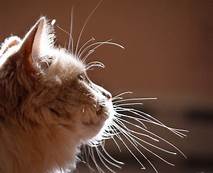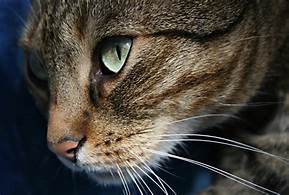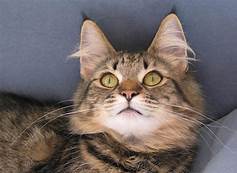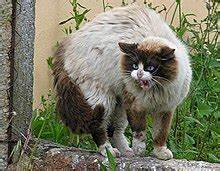Hello, two-legged readers, from Lucinda the literate cat. This post brings you your next cat language tutorial. You will find it helpful when you learn how to read your cat’s body language. May this post prove useful for you.
In the first tutorial, I discussed the language of the tail. Today I will start at our other end, and talk about all the ways we communicate with some part of our body.
We’ll cover whiskers, ears, eyes, noses, and a bit about the way cats move. We’ll start with the nose, as it might seem unusual to you when discussing communication. The nose, however, becomes like our daily newspaper. Our sense of smell is so good that we can learn many things about two-leggeds and other animals just by smelling them.
The Nose Knows
A cat’s sense of smell allows him to learn a lot about his environment. Our sense of smell is much better than in you two-leggeds. We have about 200 million cells in and on our noses that can detect odors.
We can tell if a food can be eaten, or if it’s safe to enter a new place. We use our smell to communicate because we can learn so much about a newcomer just by his odor.

We have something on the roof of our mouths that you call the Jacobson’s organ. With this added odor decoder, we can tell if meat has become rancid, and we can distinguish chemical and hormonal smells. For example, we can smell when another cat comes in heat.
We use this organ to get a better idea of what we face in our current situation. We can smell danger and disease, and this organ helps us decode that information.
Our noses work so well that they can teach us many things without our having to use spoken language. We can tell if you are sick, for example. We know your mood by your smell. We can tell if you feel friendly and curious about us by the way you smell. If you’re another cat, we can also learn much from the way your smell and how you position your tail.
We have no need to say, “Hello, how are you?” We already have an answer.
Whiskers Instead Of Fingers
Now let’s consider the whiskers. These take over a bit of the function of your fingers, as they allow us cats to feel the amount of space around us. If we need to get through a small space, these whiskers act as our measuring device, and they will let us know if the space is too small.
Our whiskers can feel air currents, so we can learn of potential danger or obstacles in the path.. They also help protect our eyes from damage.

The position of our whiskers gives you hints of our mood. If we are anxious or alert, you will notice our whiskers arched gently forward and upward.
If we are out walking, exploring the area, our whiskers will fan further forward. However, if they flatten totally back against our cheeks, watch out! We are annoyed.
Sometimes something really excites us, and then we fan those whiskers fully forward. In this position, they form a kind of net in front of our mouth.
Remember this one really important thing: Please never clip, trim, or remove our whiskers. You wouldn’t cut off your fingers, would you? Those whiskers help us navigate and avoid danger, as well as offering some communication tips.
We touch our world with our whisker tips, just you do with your fingers. Don’t take away those important sensrs.
Of Course, The Eyes Have It
What about our lovely eyes? They will give several messages about our state of mind. Do you know how to read these messages?
When it comes to the eyes, did you know that we have the largest eyes of any mammal, in relation to our body size? We have what’s called binocular vision. This wide range gives us much more peripheral vision than you two-leggeds have.

We can see in three dimensions and can judge accurately distance, depth, and size. Because we like to hunt at dawn or dusk, our ability to see in poor light gives us a good advantage.
We have something you two-leggeds call the tapetum lucidum. You can think of it as our headlights. This mirror-like dense layer of cells of highly reflective zinc also has special proteins lining the back of the eyes. These give us our night-time headlights.
Here are some messages a cat might send with his eyes:
If the pupils appear fully dilated, the cat is apprehensive or terrified. Look at many of the pictures of the Ukrainian refugee cats. It’s easy to read that message.
If your cat feels aggressive or wants to hunt, the pupils will narrow to vertical slits. However, when he feels playful and happy, those eyes may sparkle — perhaps the closest he’ll ever come to laughing.
Of course, his eyes will give him away if he wants to take a nap, as they will be half-closed.
The Better To Hear You With, My Dear
Our remarkable ears can move independently. They will pivot, swivel, and rotate. Each different position of the ears has a different meaning. For example, when erect and rotated forward, they indicate alertness.
Moving up the head, we reach the ears, which willl have many messages to give you.

If kitty has a need for self-defense, the ears lie flat on the head. If he’s ready to fight, they may rotate sideways, indicating aggression.
Perhaps they twitch in frustration or perhaps they just relax. You can learn a great deal about your kitty’s mood just from watching the ears.
CCL (Cantankerous Cat Lady) says Carlos used to sit with his back to a group of you two-leggeds, seated at a table and talking. His ears, in alert and upright position, tilted slightly back, as he listened to everything you two-;leggeds had to say.
Who knows what judgments he made from what he heard us saying?
We Walk Like We Feel
What can you learn from your cat by observing his posture and gait? These become good indicators of what he thinks or feels at that moment.
You know that a cat with his back arched, head lowered, tail down and all his fur standing on end wants to appear larger than life to try to intimidate his enemy.
Have you ever seen a cat walk sideways? CCL tells the story of Carlos and his best Kodiak friend, Tiger. CCL stood with neighbors in her yard. Carlos had joined the group, and Tiger looked on from under the porch steps.
The neighbor’s Boxer jumped the fence around her yard because she wanted to join the group. When she came into the yard, she got between Carlos and his escape route, and eyed the cat with interest.

Tiger, watching from under the steps, decided Carlos was in danger and that dog had to leave. Tiger came out from under the steps yowling a battle cry, and with fur on end, started walking sideways toward that dog, hurling insults as he advanced. In this position, he appeared a few sizes larger than he really was, from the dog’s perspective.
The dog’s attention immediately riveted on Tiger, and Carlos took the opportunity to run under the steps to safety. Tiger darted after him, and from their safe position, they hurled curses at the dog in their loudest voices.
A neighbor took the dog home and shut her back in the yard, where she stayed willingly.
You can often tell by the cat’s way of moving if he feels uncertain or nervous, in which case he may act unconcerned, to disguise his anxiety and nervousness.
If he wishes to don an invisibility cloak, he may slink past another cat with averted eyes, lowered ears, and tail low to the ground. He hopes to become invisible.
When he’s happy, he may gallop about, tail high, head and ears erect. Then he’s pleased with the world and all is well.
A Nonverbal Way Of Speaking
So we conclude this second cat language tutorial. I hope it helps you. Oh, one other thing — I can’t really teach you to understand these messages, as we deliver them silently.
We use all these body messages to illustrate our meanings, but we also communicate silently with each other. We can send and receive messages through emotions and images, something you might call a kind of telepathy. Since it silently passes from cat to cat, I don’t know how to explain it to you. Perhaps your scientists will figure it out eventually.
However, CCL says she believes she has received some of these silent messages from us. For example, several times Carlos wanted in but the cat door was closed. He made no sound; he just sat patiently outside the door. CCL must have received his message, as she went to the door and let him in.
How did she know? Did she receive a message from the cat?
What about you? Have you ever received a similar silent message from your cat? If so, please tell us about it in the comment section below this post.
Reference used for this post:
Outsmarting Cats by WendyChristensen Price: $12.92(Paperback) Prime


